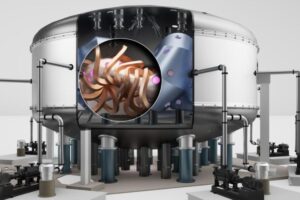Type One Energy has successfully passed the first formal design review for its “Infinity Two” stellarator fusion reactor power plant that aims to deliver 350 megawatts of electricity to the grid by the mid-2030s.
The U.S.-based company has been developing the technology for a potential project with the Tennessee Valley Authoritywhich provides power to a seven-state region in the Southeast.
The progress on the Infinity Two reactor design and the partnership with TVA have been turning heads in the global energy industry, according to a report by Interesting Engineering.
In a press releasethe company shared that “several prominent energy utilities and industrial companies have expressed an interest in Infinity Two and participation in Type One Energy’s deployment of its first-generation fusion power plant technology.”
Stellarator fusion reactors such as the Infinity Two use strong electromagnets to create a twisting magnetic field to confine plasma and create the right conditions for fusion.
These types of reactors require less injected power and offer greater design flexibility, but they are also incredibly complex to engineer.
Watch now: Does clean energy really cause blackouts?
Researchers at the Princeton Plasma Physics Laboratory even created customized code called QUADCOIL to help optimize and accelerate the design process for these types of reactors.
According to Interesting Engineering, this is the first time that a fusion power plant with such a significant output goal has passed an independent technical review, which could be a turning point in the race to commercialize the sector.
Fusion holds the promise of nearly limitless carbon-free energy, which could serve as a complement to other sustainable energy sources such as solar and wind. While it’s still a work in progress, there have been many advances in the field.
The Infinity Two’s design review board includes Type One Energy’s chief technology officer, Thomas Sunn Pedersen, as well as prominent outside experts such as George H. “Hutch” Neilson from the Princeton Plasma Physics Laboratory and Paolo Ferroni from Westinghouse Electric Company, according to the report.
The project received high praise from Neilson, who said: “It is the first serious fusion power plant design that I’ve seen. The work they’ve done to date provides a sound foundation for continued design development of what could be the first system to produce net electricity from fusion.”
The record-breaking Wendelstein 7-X fusion project at the Max Planck Institute for Plasma Physics in Germany has already proved the potential for stable steady-state operation at a large scale for stellarator designs, paving the way for projects such as the Infinity Two.
Soon, we may be able to stop relying on dirty fuels from the oil and gas industry and instead enjoy the clean, sustainable energy output from fusion reactors without polluting the environment.
Fusion reactors are incredibly efficient. With just over 130 pounds of deuterium and tritium, they can create the same amount of energy as 275,000 tons of petrol.
“The energy industry needs more reliable, clean, power generation technology that can meet the rapidly increasing demand for electricity and we are delivering a commercially compelling solution,” said Christofer Mowry, CEO of Type One Energy.
Join our free newsletter for weekly updates on the latest innovations improving our lives and shaping our futureand don’t miss this cool list of easy ways to help yourself while helping the planet.











